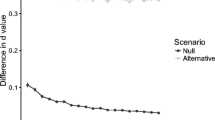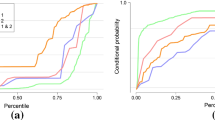Abstract
This paper reports on the relevance of attention checks for online panels, e.g., M-Turk, SurveyMonkey, SmartSurvey, QualTrics. In two SmartSurvey studies approximately one third of the respondents failed a check that instructed them to skip the question. Attention-enhancing tools reduce this to approximately one fifth. The failure rate is not affected by replacing multiple-item scales with single-item measures. We find that failing the attention check relates to other attention indicators and that decreased attention levels often apply across the length of the survey. In support of relevance, our empirical findings show respondent inattentiveness systematically biases survey responses.

Similar content being viewed by others
References
Barone, M. J., Lyle, K. B., & Winterich, K. P. (2015). When deal depth doesn’t matter: how handedness consistency influences consumer response behavior to horizontal versus vertical price comparisons. Marketing Letters, 26(2), 213–223.
Bergkvist, L., & Rossiter, J. R. (2007). The predictive validity of multiple-item versus single-item measures of the same construct. Journal of Marketing Research, 44(2), 175–184.
Berman, J. Z., Levine, E. E., Brach, A., & Small, D. A. (2015). The braggart’s dilemma: on the social rewards and penalties of advertising prosocial behaviour. Journal of Marketing Research, 52(1), 90–104.
Billiet, J. B., & McClendon, M. J. (2000). Modeling acquiescence in measurement models for two balanced sets of items. Structural Equation Modeling, 7(4), 608–628.
Comley, P. (2005). Understanding the online panelist. ESOMAR. http://www.websm.org/db/12/11356/Bibliography/Understanding_the_online_panellist.
Echambadi, R., & Hess, J. P. (2007). Mean-centering does not alleviate collinearity problems in moderated multiple regression models. Marketing Science, 26(3), 438–445.
Emrich, O., & Verhoef, P. C. (2015). The impact of a homogenous versus a prototypical web design on online retail patronage for multichannel providers. International Journal of Research in Marketing, 32(4), 363–374.
Holbrook, M. B., & Batra, R. (1987). Assessing the role of emotions as mediators of consumer responses to advertising. Journal of Consumer Research, 14(4), 404–420.
Holbrook, A. L., Green, M. C., & Krosnick, J. A. (2003). Telephone versus face-to-face interviewing of national probability samples with long questionnaires. Comparisons of respondent satisficing and social desirability response bias. Public Opinion Quarterly, 67(1), 79–125.
Johnson, J. A. (2005). Ascertaining the validity of individual protocols from web-based personality inventories. Journal of Research in Personality, 39(1), 103–129.
Kamakura, W. A. (2015). Measure twice and cut once: the carpenter’s rule still applies. Marketing Letters, 26(3), 237–243.
Kaminska, O., McCutcheon, A. L., & Billiet, J. (2010). Satisficing among reluctant respondents in a cross-national context. Public Opinion Quarterly, 74(5), 956–984.
Kapelner, A., & Chandler, D. (2010). Preventing satisficing in online surveys: a “Kapcha” to ensure higher quality data. San Francisco: Paper presented at the Crowd Conference.
Krosnick, J. A. (1991). Response strategies for coping with the cognitive demands of attitude measures in surveys. Applied Cognitive Psychology, 5, 213–236.
Krosnick, J. A. (1999). Survey research. Annual Review Psychology, 50, 537–567.
Malhotra, N. (2008). Completion time and response order effects in web surveys. Public Opinion Quarterly, 72(5), 914–934.
Martin, C. L. (1994). The impact of topic interest on mail survey response behavior. Journal of the Marketing Research Society, 36(4), 327–338.
Meade, A. W., & Craig, S. B. (2012). Identifying careless responses in survey data. Psychological Methods, 17(3), 437–455.
Oppenheimer, D. M., Meyvis, T., & Davidenko, N. (2009). Instructional manipulation checks: detecting satisficing to increase statistical power. Journal of Experimental Social Psychology, 45, 867–972.
Putrevu, S., & Lord, K. (1994). Comparative and non-comparative advertising: Attitudinal effects under cognitive and affective involvement conditions. Journal of Advertising, 23(2), 77–91.
Rossiter, J. R. (2002). The C-OAR-SE procedure for scale development in marketing. International Journal for Research in Marketing, 19(4), 305–335.
Van Herk, H., Poortinga, Y. H., & Verhallen, T. M. M. (2004). Response styles in rating scales: evidence of method bias in data from six EU countries. Journal of Cross-Cultural Psychology, 35(3), 346–360.
Weijters, B., Baumgartner, H. and Schillewaert (2013). Reversed item bias: an integrative model. Psychological Methods, 18(3), 320–334.
Zhang, C., & Conrad, F. G. (2013). Speeding in web suveys: the tendency to answer very fast and its association with straightlining. Survey Research Methods, 8(2), 127–135.
Acknowledgements
The authors are grateful for feedback provided by Harald van Heerde, the marketing group at the Radboud University and the School of Communication, Journalism and Marketing at Massey University. We also express our gratitude to Siara Khan for assessing the use of attention checks in the marketing literature.
Author information
Authors and Affiliations
Corresponding author
Rights and permissions
About this article
Cite this article
Paas, L.J., Morren, M. PLease do not answer if you are reading this: respondent attention in online panels. Mark Lett 29, 13–21 (2018). https://doi.org/10.1007/s11002-018-9448-7
Published:
Issue Date:
DOI: https://doi.org/10.1007/s11002-018-9448-7




